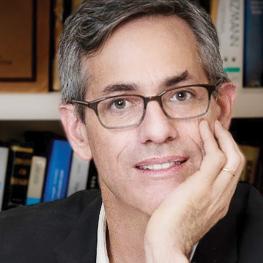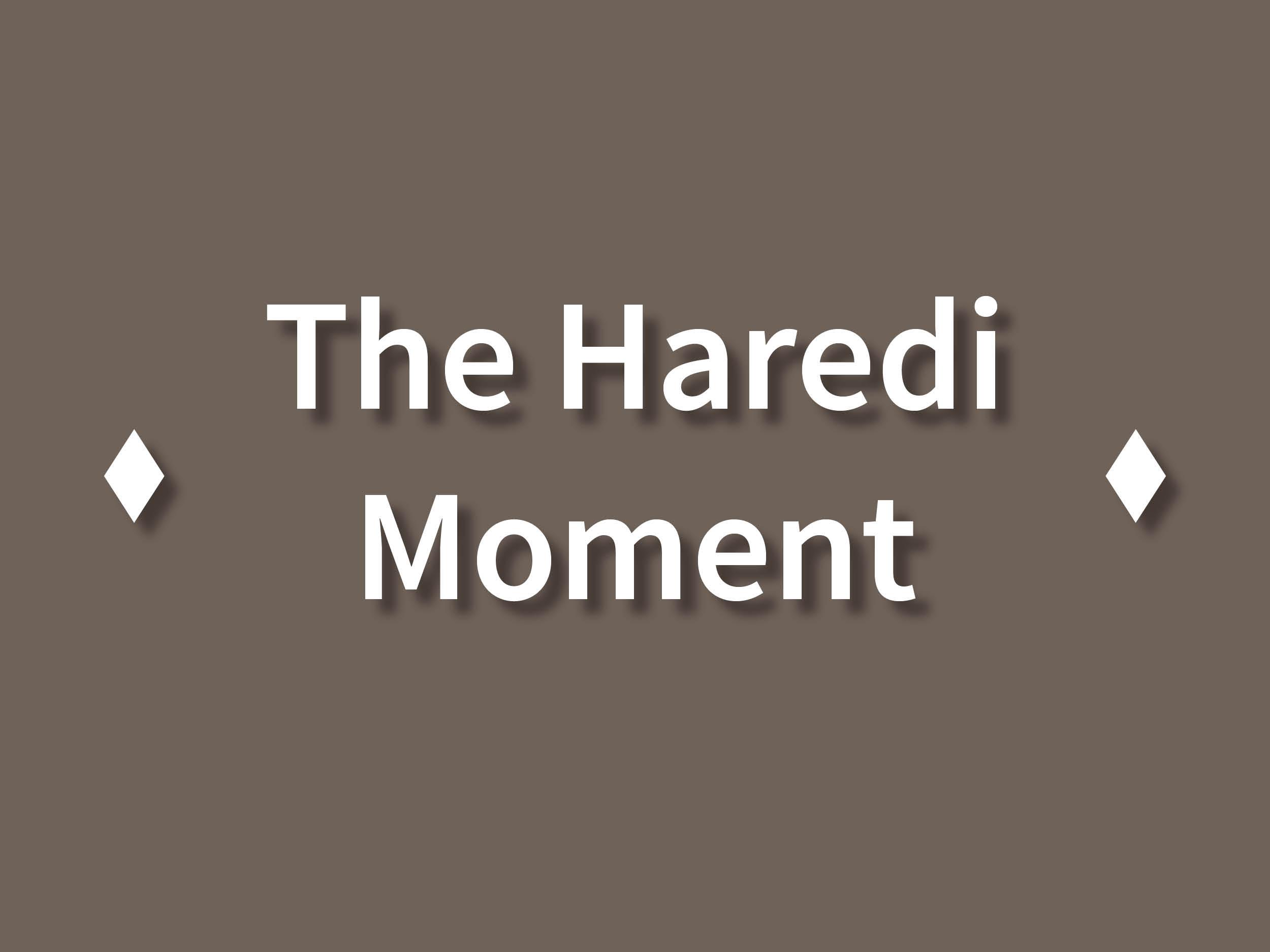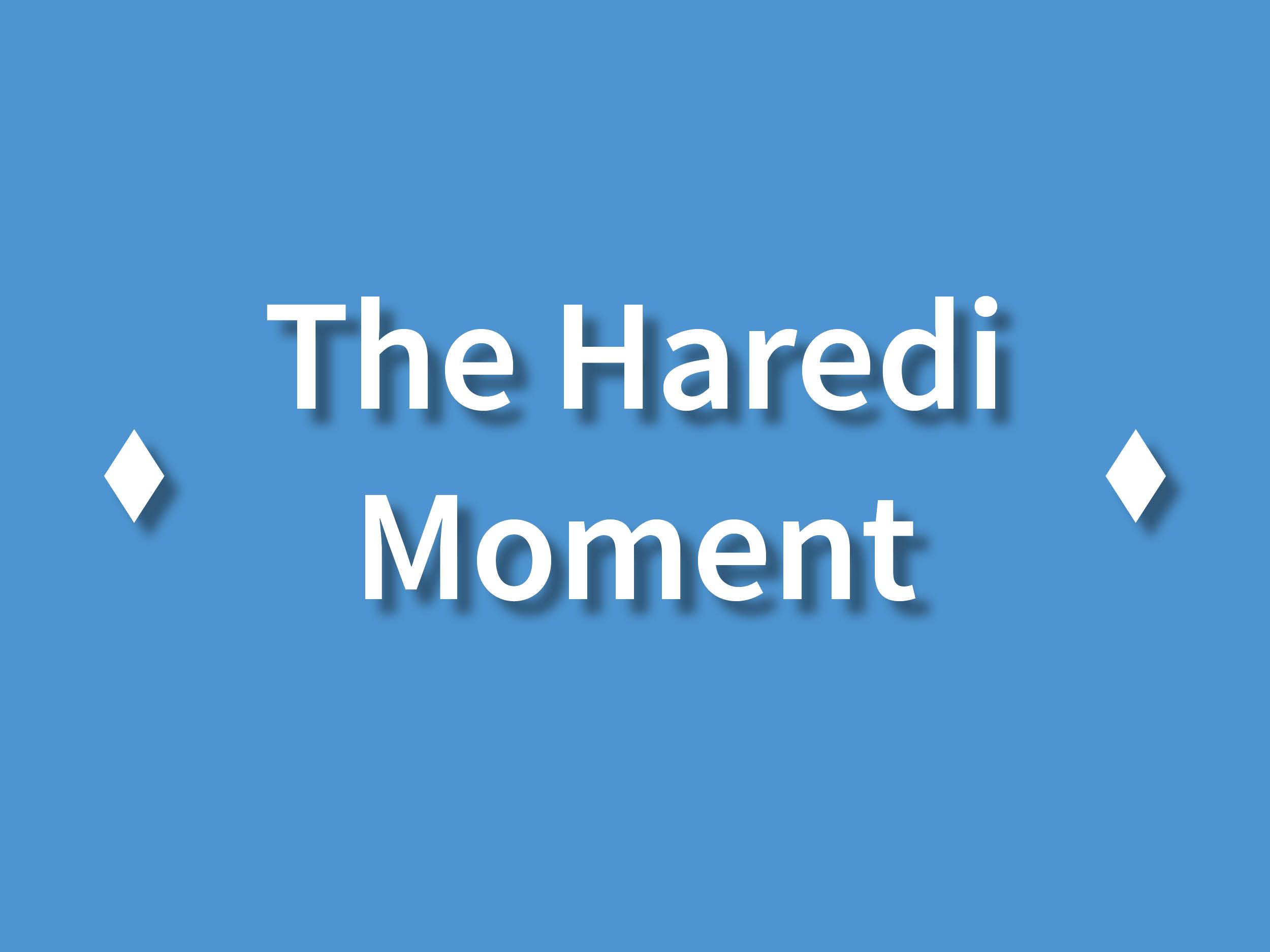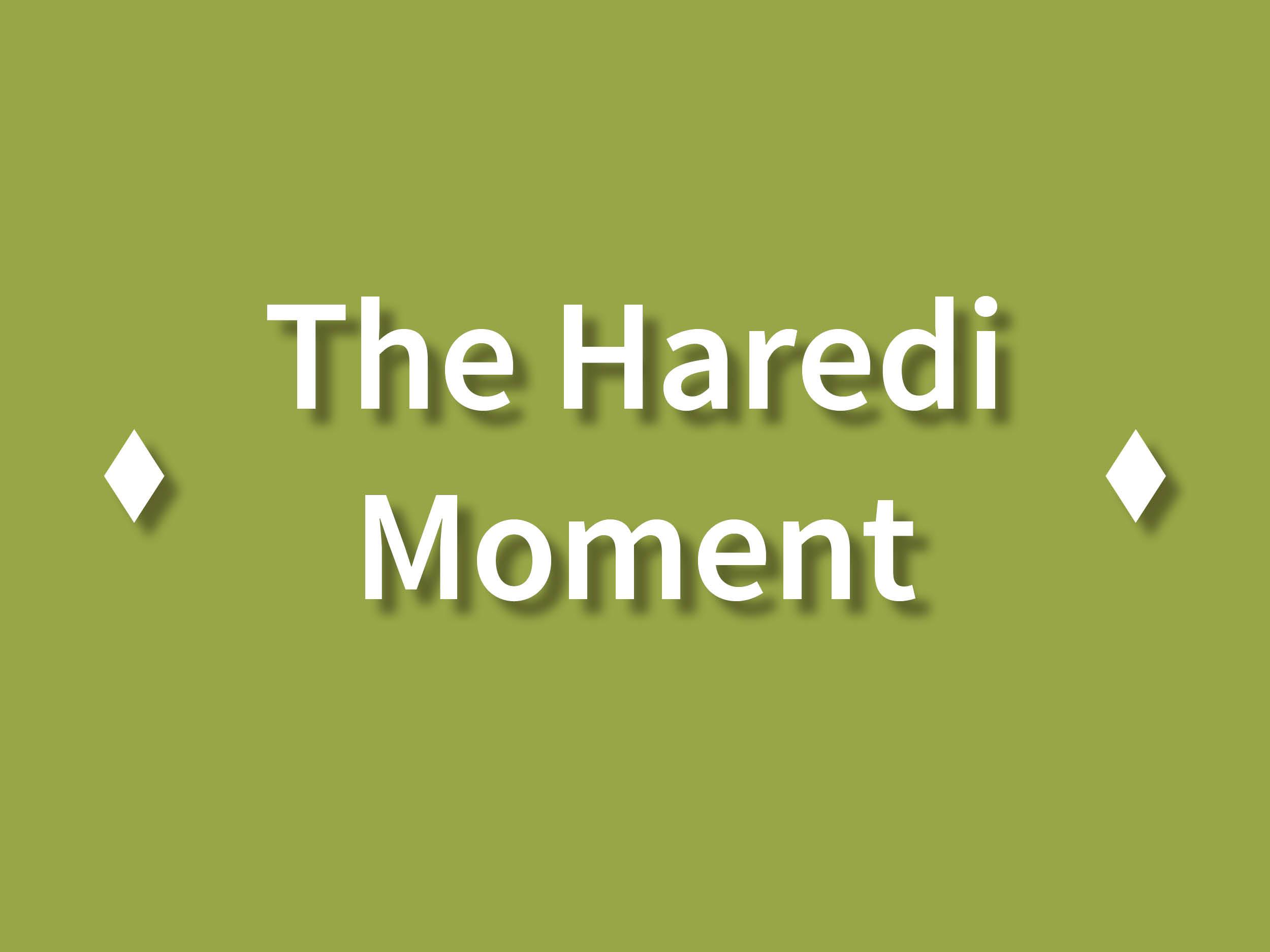The Haredi Moment: A Postscript on the Tragedy at Mt. Meron, Part 4
A postscript to our forum on recent developments in the ultra-Orthodox world, featuring Yoram Bilu, Samuel Heilman, Michal Raucher, and Naomi Seidman on the tragedy at Mt. Meron.
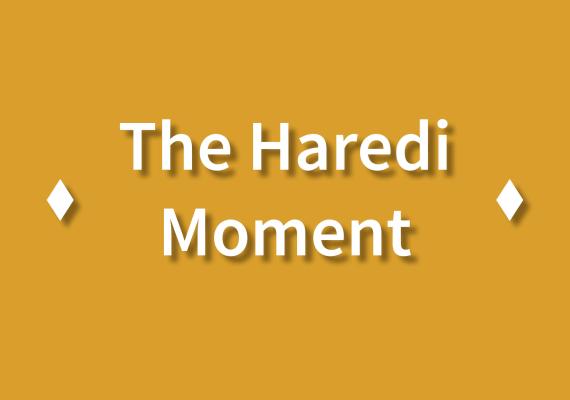
In April, JQR convened a three-part online forum to analyze the “Haredi moment” of 2020. The COVID-19 crisis and the U.S. presidential election highlighted both lingering patterns and new modes of Haredi behavior, especially evident in the broader public sphere. A few short days after the last of the three forum panels was posted, on Lag Ba-Omer (April 30), a tragedy took place at Mt. Meron in which 45 pious Jews, most of whom were Haredim, were killed in a stampede on the grounds of the site where Rabbi Shimon bar Yochai, venerated by traditionalists as the author of the kabbalistic book Zohar, is buried.
In the wake of the tragedy, commentators rushed to weigh in, calling attention to the abdication of responsibility of the state in regulating the Meron site, the seeming autonomy accorded Haredim there, the decline of the leadership structure of the community, and the various explanations that Haredim themselves offered for the tragedy. In line with our commitment to understand the Haredi moment, we invited four distinguished scholars—Yoram Bilu, Samuel Heilman, Michal Raucher, and Naomi Seidman—to explicate what Meron is, why it is so significant, and what the ritual of saint veneration there tells about Haredim, politics, and gender dynamics. Many of the scholars who participated in the four JQR fora are partners in a loose collaborative, the “Haredi Research Group,” that is committed to providing a deeper understanding of Haredim and their place in the U.S., Israel, and other major population centers.
David N. Myers
Contextualizing the Disaster at Meron
Yoram Bilu
Making sense of the terrible disaster at Meron by just referring to “the writing on the wall” is too facile. It is true that the absence of central control and adequate enforcement of safety regulations in Rabbi Shimon bar Yochai’s sanctuary during the Lag Ba-Omer hillula (festivity) was known for years. But a deeper understanding of the event may be gained by situating the pilgrimage in a wider context, that is, by theorizing and historicizing it.
Theoretically, Victor Turner’s seminal work on pilgrimage stands out as a singular attempt to create a grand scheme, “applicable to all cases in all societies.”[1] A conceptual cornerstone of Turner’s theory is the ethos of communitas that supposedly emerges among pilgrims during the liminal period of moving from the familiar to the anti-structural center “out there.” Communitas is defined as “a spontaneously generated relationship between leveled and equal total and individuated human beings, stripped of structural attributes.”[2] The bonds of communitas are marked by a spirit of fraternity and comradeship whereby “the other becomes a brother.” Turner’s ideas were highly influential at the time, but they also drew wide criticism from students of pilgrimage in various cultural settings. As we shall see, the critics’ main argument—that the boundaries between groups of pilgrims are not dissolved—is valid for the Meron hillula as well.[3] Ironically, however, if we take Turner’s concepts seriously, it can be argued that the eminent anthropologist unwittingly sowed the seeds for understanding the disastrous stampede at Meron by highlighting the fluid, boundless, ecstatic aspects of the pilgrimage experience. The dark side of anti-structure, which remains covert in Turner’s theory, is chaos. Note the sporadic occurrence of mass disasters in major pilgrimage sites like Mecca and the Holy Sepulchre, or in non-religious settings with the same deep structure (or anti-structure) such as rock concerts and soccer games.
Reviewing the historical changes that the Meron hillula has undergone in the last century is conducive to a more nuanced reading of the communitas controversy and its implications for the event under scrutiny. In today’s harsh reality, when holy sites common to Jews and Muslims are viewed as time-bombs on the road to perdition, it is surprising (but in line with Turner’s ideas) to find out that before 1948, local Arabs were part of the scene at Meron. Their presence there goes back to the 13th century, when cultic practices on the site were first mentioned in texts.[4] It is no less surprising to find out that, contrary to popular notions of holy sites as petrified traditions from a remote past, the place of the celebration then was not the sanctuary of Shimon bar Yochai (known by the acronym RaShBY), but the nearby burial cave of Hillel and Shammai; and the time of commemoration was not Lag Ba-Omer, but the Second Passover (14 Iyar) three days earlier.
Arab visitors disappeared from Meron in 1948, but their style of celebration in the ziyyara (Arabic: visit), marked by camping, socializing, and feasting near the shrine, was allegedly restored afterwards. This happened when new immigrants from Muslim countries adopted the sanctuary as a major pilgrimage site. Moroccan Jews, for whom the veneration of saints in general and of RaShBy in particular were major ingredients of their traditional culture, were overrepresented among them.[5] The following lamentation of Yosef Ha-Glili, one of the site’s oldest and most loyal adherents, is instructive about the influx of Mizrahi Jews at Meron in the 1960s and 1970s. (Ironically, many of them were coming from the “Far West,” el-Maghreb el-Aksa.)
Where are the dancers of olden times? The joy, the exuberance, the ecstasy? An unrecognizable monster, difficult to describe, has emerged in their place, a kind of mass, unorganized picnic, on the order of the Wild West, or an Oriental fantasia. Something like the ziyyara of Nebi Rubin in the sands of old Yavneh, or alternatively the fantasia of Nebi Musa in the 1920s… Some hundred thousand people make the pilgrimage to Meron, may their numbers increase, most of them from among the new immigrants. And they did not have the privilege of drinking in the glory-draped atmosphere of old times, which was the lot of the elders of the old community. These pilgrims celebrate in accordance with their own notions, and in the ways they saw among their neighbors in the lands of their exiles.[6]
Ha-Glili here compares the hillula at Meron to the popular pilgrimages made by Palestinian Muslims before 1948. Indeed, at Meron the distinct celebratory style of Moroccans became increasingly evident in the 1960s through the 1980s. It could be heard in the widespread use of the Jewish dialect of Maghrebi Arabic or in the Moroccan-style music played and sung by the pilgrims, seen in the Moroccan dress donned by many participants—like the white robe (jelaba) and red fez, smelled in the aroma of traditional Moroccan dishes and araq liquor, and experienced in the large Moroccan-style welcoming tents, some of which displayed, alongside photographs of Israeli leaders and the banners of Israel Defense Forces units, portraits of Mohammed V, the late king of Morocco.
Ashkenazi Hasidim too were present in the hillula in those years but in smaller numbers; and their forms of celebration were notably in contrast with those of Mizrahi pilgrims. Moroccans in particular preferred to come in large family groups, and many made arrangements to spend several days in the tent city that sprang up in the woods around the site. Here, in the outdoors, they spent their time together, ate and drank, sang and lauded the saint, met old acquaintances, and shopped at the stands that sprang up, like a colorful fair, on the path to the tomb. From there they ascended to visit the graves of Rabbi Shimon and his son Rabbi Elazar, to ask for their intercession and to offer fulsome thanks for wishes fulfilled. As an expression of their gratitude they brought trays piled high with sweets for other worshippers.
By contrast, the Ashkenazi Hasidim at Meron stood out with their uniform dress and their attendance at the hillula’s central ceremonies, but they spent less time at the site, and generally did not sleep there. They hurried past the places of fun and leisure, which they abhorred as hedonistically secular, especially because men and women mingled there. Squeezing into the central hall in which the pair of tombs are situated, and into the adjacent synagogue, into the balconies and onto the roofs of the site and its inner court, they danced and sang ecstatically in honor of the tsadik. Fathers bearing their three-year-old sons on their shoulders would dance, surrounded by circles of male Hasidim, in observance of the halaka, the first haircut.[7] Women poured out their hearts in the women’s section of the hall and watched the men dancing and the haircutting ceremonies from the places set aside for them.
The prominence and energy of the Ashkenazi Hasidim at the hillula led Kenneth Brown, an English anthropologist who visited Meron at the beginning of the 1980s, to view the activity there as a symbolic expression of the relations between Ashkenazim and Mizrahim in Israeli society at large: “The pilgrimage fair at Meron brought together Oriental and European Jews but it did not integrate them. The separation existed here as it did in most sectors of life in Israel. The inequalities and imbalances should be noted: The Ultraorthodox European Jews, a minority but nonetheless at the center, dominated the ritual aspect of the pilgrimage. The Oriental Jews, although a majority, remained on the periphery.”[8] Brown’s symbolic reading of the pilgrimage, although suggestive, appears overstated. The Haredim were hardly classic representatives of the Israeli elites and the dispersion of the Mizrahim in the woods around the site seemed to be a reflection of their traditional patterns of celebrations at saints’ graves. In any case, the majority–minority relationship on which Brown had based his analysis was reversed in recent decades, as the hillula has undergone a significant “Haredization,” with large numbers of Ashkenazim including Hasidim.
As a general matter, the popularity of RaShBY’s hillula has grown in the twenty-first century, and the numbers of pilgrims there has reached 500,000. Many Mizrahi celebrants still frequent the site, but the distinctively Maghrebi style of the celebrations has subsided. This attenuation is not surprising. The contribution of Moroccan Jews to the renaissance of saint veneration in Israel was promoted by new Moroccan immigrants who had been exposed to the cultic traditions in their home country and accommodated them to the local scene.
As against this numerical and cultural attenuation, strongly noticed since the turn of the century, the number of Haredim at Meron, Ashkenazi as well as Mizrahi, is growing systematically. The salience of Hasidim of all sects is particularly noted. Along with it, the scene at Meron has changed as a result of the continuing endeavor of rabbinical and state institutions to curb and regulate the carnivalesque flow of the celebrants (in Turner’s terms, to move from spontaneous to normative communitas). Thus, unauthorized peddlers and ritual slaughterers have been pushed out of the precinct, and pilgrims now approach the sanctuary through a web of marked and fenced paths specifically designated for families, men or women-only, and Cohanim (descendants of the ancient priestly order who avoid sites of death), respectively. When I first visited Meron and other saints’ sanctuaries in the early 1980s, gender separation was not enforced. Nowadays an opaque fence divides the burial hall at Meron (and in all other holy sites in Israel) into men’s and women’s sectors as one encounters in an Orthodox synagogue.
We will never know whether these processes of growing state institutionalization and regulation delayed the disaster at Meron or expedited it. The sanctuary itself is fragmented into a mosaic of charitable trusts (hekdeshim), non-profit associations, and Hasidic groups, and the authority of the state is nowhere to be felt there. In this respect, the state of affairs at Meron is a metonym for the near-total autonomy that Haredim in general have been able to secure through their active participation in and savvy maneuvering of the Israeli political system. The symbiotic relationship between the Haredi community and the state that lends support to the ultraorthodox “enclave culture”[9] is evident at Meron as well. State-based or state-related bodies and organizations are responsible for building and managing the elaborate logistical infrastructure required for transporting the celebrants to and from Meron and for taking care of their basic necessities and well-being while there. It is clear, however, that even the most effective administrative work on the part of the governmental and municipal organizations in charge cannot cope with the ecstatic attraction of believers to the holy site, on the one hand, and the exceptional leeway granted by the government to Haredim for their political support, on the other.
Yoram Bilu is professor of anthropology and psychology emeritus at the Hebrew University of Jerusalem.
Meron, Lag Ba-Omer, and What Happened
Samuel Heilman
As an American social anthropologist with a particular interest in contemporary Orthodox Jews, I long ago realized that there was no substitute for spending time in Israel. During several of those research trips I became especially interested in the phenomenon of pilgrimages, which I understood was an important undercurrent of the attraction that Orthodox Jews had in visiting Israel. Not only did they see the biblical land as a place for a pilgrim's journey—as had so many before them—but there were special places in it that were exceptionally attractive. These were locations that had drawn Israelis too, and that had elaborate rituals connected with the pilgrimage. Most appealing were those places that had particular days or times when people came as well as detailed spiritual “benefits” for those who made the trip.
No place stood out more clearly than Mount Meron and the tomb of Rabbi Shimon ben Yochai (“RaShBY”) on Lag Ba-Omer, which I visited several times over the course of my career. The basic idea had been to go up a series of paths and slippery steps into a tiny courtyard that surrounds the little stone building in which the tomb is situated, enter and pray on this day for the intercession of RaShBY for one’s welfare, and then exit, letting others take your place. Interesting to note is the fact that the first source we know of who made the connection between Meron and RaShBY was a twelfth-century Jewish traveler by the name of Jacob ben Netanel Ha-Cohen, who wrote a travel diary of his visit to the Holy Land. On the other hand, other medieval pilgrims’ accounts of Meron—such as those of Benjamin of Tudela and Petachia of Regensburg—do not.
One of those many trips I took to this pilgrimage site came in 1989 when I was working on what would become Defenders of the Faith and appears in a chapter titled “Mass Pilgrimage.” After the sixteenth-century mystic Isaac Luria singled it out, it had long been associated with Sephardi Jews as well as those of Moroccan descent for whom pilgrimages to the graves of “saints” became an important collective religious experience, but by the time I had begun going to Meron, it had become an important occasion for Ashkenazi Jews as well as all sorts of Orthodox. More than that it also turned into a kind of folk festival, an occasion to celebrate the spring in the natural splendor of that area. People began gathering around the mountain days in advance, combining a camping trip with the pilgrimage. As more people converged on the area, there developed a whole economy around the event, and sellers of everything from “holy” books, trinkets, and amulets to music tapes or disks, and of course people who sold drinks, snacks, souvenirs, and the like. Bus companies did a lot of business bringing pilgrims to and from the mountain. Various communities organized their own rides.
By the time I went for the first time with a group of Haredi Jews from Jerusalem, buses were running every 20 minutes from the Meah She’arim neighborhood to Meron from 1 AM the day before Lag Ba-Omer until 9:30 at night the next day. And that was just one neighborhood in one city. Each company offered its own incentives. One promised separate seating for men and women, another promised drivers who did not desecrate the Sabbath, a third low prices, and so on.
The pilgrimage also became associated with the ceremony of the halaka, a boy’s first haircut around his third birthday (or as the Hasidim like to say, “the day he gets his peyos [ forelocks]”), and has become an important family event attached to this pilgrimage. It had become a custom that the shorn locks would be thrown in the large bonfires that were associated with the day. Accordingly, barbers— “professional” and amateur—also set up stands at the mountain, preferably near those bonfires, which in turn were ignited near the tomb.
Each group, of course, wanted to have its own people closer, as well as room for the family to watch the child held aloft after the shorn locks are burned. Moreover, as the Hasidim became a larger presence at the pilgrimage, their Rebbes played a larger role in the occasion; wherever a Rebbe appears, the Hasidim are sure to follow in large numbers, hoping to eclipse the crowd that some other Rebbe draws. While the Boyaner Rebbe had by tradition been the one to light the first bonfire, over the years each Rebbe whose Hasidim came wanted to light his own fire. Unlike other Hasidic gatherings that normally only attracted males, because of the halaka haircuts, families were coming, adding to the size of crowds.
In time, the Ashkenazi crowds seemed to outnumber the Moroccans and the other Jews who had been the early devotees. As the political power of the Shas party that represented this Mizrahi population grew in influence, after its founding in 1984, a competition grew between the two streams of Jewry over who would dominate the occasion and the site. Nothing grows an event more than competition. In time, each stream had its own pathway to the tomb and separate entrances. The Haredim also demanded paths that divided men and women, while the others did not necessarily obsess over gender mixing on the way to the tomb. All these streams and paths converged near the tomb and at the exits, creating a series of unavoidable bottlenecks.
Beginning in the mid-1990s with its growing outreach program, manic messianism, and religious imperialism, Chabad began trying to dominate the pilgrimage. It plastered the site with posters of its Rebbe, and then screens with films of him. The boosters of RaShBY tried to compete but they had no movies or real photos to display. Other “saints” started making appearances. The varieties of competition only increased the numbers of pilgrims and hangers-on, as well as the curious—including anthropologists and tourists.
Yeshivas and girls’ seminaries sent or at least condoned the attendance of their students at the event. Diaspora kids who spent gap years at these institutions soon joined the flow. Meron became an international destination on Lag Ba-Omer.
But the place was not made for the hundreds of thousands who converged upon it, nor were the many who came organized in any holistic way. So difficult was the journey that one year when I brought a group of twelve scholars, including two Indian Sanskrit experts from the Institute of Advanced Study in Jerusalem and six women, all became lost in the crowd, the last two in an unstoppable stream that swept them from my clutches and into the tomb. Even the two Indians, who had years of experience on crowded buses in Calcutta and Delhi, were not quite prepared for Meron on Lag Ba-Omer.
By the time of this year’s pilgrimage, all of the crowding and competition among groups had become mixed with the political ambitions of the Orthodox of all persuasions: Ashkenazi, Mizrahi, and nationalist. Meanwhile, the state had back-pedaled from trying to limit and control the event, unlike its action a week earlier when it limited the number of Eastern Orthodox Christian pilgrims to the Easter celebrations at the Church of the Holy Sepulchre in Jerusalem. Many Haredim chafed at the idea of the Health Ministry continuing to impose COVID-19 restrictions. Interior Minister Aryeh Deri, head of Shas, declared that “visitors to Meron need not be limited by the Health Ministry’s concerns regarding Covid, and not because Covid has died down, but rather because it doesn't appreciate how Rav Shimon Bar Yochai's merit determines what happens.” This point is also echoed in an article in the Haredi newspaper HaModia from a few years ago, about how Meron is, “from the perspective of physics, a disaster waiting to happen, but the workings of Hashem and the merit of Rabbi Shimon prevents that from occurring.”[10]
Many forces joined together in setting the stage for the disaster this year that many had been predicting. The bottlenecks, wild enthusiasms, religious competition, political machinations, belief in divine providence and the protection of saints, and the sense of exhilaration that Covid was under control at least outdoors, led to the accident. These forces were exacerbated this year by two additional factors. First, after a year of pandemic when hardly anyone made the pilgrimage, there was a pent-up desire by many to go; this may have led to a kind of abandon and enthusiasm that prompted even more pushing and shoving, even with a relatively smaller crowd than in years past. Second, coming in the midst of politicking over a new government which is dependent on Orthodox voters, right-wing politicians, including Minister Deri, pulled out all restrictions, deflected concerns about safety, and encouraged pilgrims to come, playing the populist card. The results were disastrous and, as of this date, no full inquiry as to who is responsible and what lessons should be learned has been convened.
Samuel Heilman is Distinguished Professor of Sociology emeritus and Harold M. Proshansky Chair of Jewish Studies emeritus, Queens College and CUNY Graduate Center.
Conformity and Critique among Israeli Haredim
Michal Raucher
Naomi Seidman
Haredim are characterized by their uniformity, their collectivity, the apparently identical ways they dress. Photographers seem ineluctably drawn to imagine Haredim as a “sea of black,” a kind of ethnography that in the flatness of its representation approaches abstraction. Though scholars and insiders see diversity within this apparent uniformity, recognizing meaningful distinctions in the cut of the coat, the type of hat or kippah, the style of facial hair, a kind of poetics of representation encourages the public to view Haredim as an undifferentiated mass. And even among those who do register certain nuances, many assume that Haredim share roughly the same ideas about politics, gender roles, and adherence to rabbinic rulings. Those who see conformity in appearance assume this stands in for conformity of ideas.
It is not only photographers or outsiders who read conformity and collectivity in the ways Haredim are represented in the public sphere. Collectivity is in fact a powerful engine for the construction of Haredi identity. It is in crowds that the size and power of these communities in their new ascendancy become visible to insiders as well as outsiders. It is not only that Haredim gather in the thousands for funerals, celebrations, demonstrations. To be Haredi is to gather with other Haredim, to see yourself reflected in a crowd, to follow implicit and explicit community standards, to sway along with other bodies moving as if as one. This directive to join the crowd is an invitation to submerge individual difference within group conformity but it is also its own reward, in the “collective effervescence” that is available only to a crowd.
But conformity is not the whole story. Buried in areas that are often unseen is an internal critique of Haredi society that has been simmering with increasing force in recent years. Pointed and angry critique of the community’s leaders and activists (askanim) by those Haredim who had access to independent sources of information about health measures followed swiftly in the wake of the high death toll from Covid-19. The tragic disaster at Mt. Meron in Israel, which resulted in the death of 45 boys and men, almost all of them Haredi, saw similar discontent with Haredi practices and leadership. As generally happens after tragedies that seem as if they could have been avoided, there have been many different ascriptions of blame, on all sides. Unsurprisingly, secular Israelis and those in the Israeli government blame Haredi separatism and autonomy for creating an environment in which freedom of religious expression trumps police and safety measures that might have protected lives. Some blamed the power dynamics of the Israeli parliamentary system, which accords Haredim power and renders governmental entities eager to avoid entanglement with Haredim, even at the expense of safety restrictions, which had been discussed but never implemented.
When speaking publicly, many Haredi leaders are likely to view these deaths as divinely ordained punishments for laxity in community standards or other sins. Rabbi Chaim Kanievsky, who, at age 93 is widely considered the rabbinic leader of the thousands of Lithuanian or “yeshivish” Haredim, ascribed the tragedy to divine causes but resisted the further rendering of the tragedy as a punishment for communal sins, explaining that “it is a decree from Heaven and we cannot know the considerations from heaven.” But pushed by his son, Yitzhak Shaul, about how the community could fix itself after the tragedy (what “tikkun” they could do), Rabbi Kanievsky responded that men needed to strengthen their study of Torah, women needed to be more careful with the laws of modesty, and everyone needed to be more vigilant in making the blessing for ritually washing one’s hands before eating. Despite how these remarks were received by many, Rabbi Kanievsky did not lay blame for the tragedy on women’s immodesty. He was rather laying out in schematic and formulaic fashion the division of labor within the Haredi world, in which men do their collective part by studying Torah and women contribute by maintaining codes of modesty. In other words, a renewed commitment to conformity of actions is understood to be the appropriate response to tragedy.
Behind the scenes, however, Haredi individuals continued to express their frustration with the Haredi leadership. Some had been increasingly breaking with the collective since the early weeks of the pandemic, when a failure of rabbinic leadership to call for heeding the new health restrictions was perceived as directly responsible for the high infection and death rates in the Haredi world. Yitzchak Roth, a former editor of the Haredi daily newspaper, Yated Ne’eman, blamed Haredi leaders who had previously objected to any limits on gathering at Meron but who were now blaming the disaster on those who organized the event for not instituting any safeguards. Additionally, in the aftermath of the Meron tragedy, the families of the victims called for the establishment of a state commission to investigate the causes of the disaster. These families also called on the Haredi members of Knesset to vote in favor of this commission.
This year’s Lag Ba-Omer celebration was not the first time that Haredim criticized the leadership regarding events at Mount Meron. In 2019, rabbinic leaders invited Rabbi Eliezer Berland, a convicted rapist and previously the leader of the Shuvu Banim yeshiva (associated with Breslover Hasidism), to participate in the ceremony. Following his release from prison in 2017, he had been slowly making his way back into the Haredi public, a move that was welcomed by many rabbis. Faini Sukenik, a self-identified feminist Haredi activist, voiced her objection to Berland’s involvement in the Lag Ba-Omer celebration, calling out the rabbis who had embraced him and imploring the Haredi public to voice their criticism. Esti Shushan and Tali Farkash, two outspoken Haredi women, also objected to Berland being present at Meron. As Michal Kravel-Tovi writes, they criticized the Haredi leadership for their “corruption of power and the buying of silence.”[11]
Understanding Haredim requires attention not only to the nuances often lost in the depiction of uniform collectives but also to the non-Haredi or secular “gaze,” which often projects its own anxieties and nostalgia onto Haredim. The power (and sometimes horror) of collectivity takes shape within a larger world that no longer knows this type of collectivity, that rarely experiences it in this “thick” a form. Certainly, collectivity in these mass events is often visibly erotic, in ways that are foreign but half-remembered by witnesses who invest their erotic energies differently but may dimly feel that they are missing something that these “other people” have. The horror, anger, disgust and curiosity provoked by images of Hasidic masses—and not only in the secular Israeli public, which recognizes Haredim as political rivals—express the tensions and failed hopes of secular modernity as much as they reflect on Haredim themselves. Haredim are a (black and white) screen for a whole host of other issues revolving around religion and modernization, power and collectivity, modesty and sex, the individual/family/collective, and the limits of liberal tolerance, for Haredi and secular, Jews and non-Jews-alike.
Michal Raucher is assistant professor of Jewish studies at Rutgers University. Naomi Seidman is Chancellor Jackman Professor of the Arts, University of Toronto.
[1] See Victor Turner, “The Center Out There: Pilgrim’s Goal,” History of Religions 12.3 (1973): 191–230; Victor Turner, Dramas: Fields, and Metaphors (Ithaca, NY: Cornell University Press, 1974); Victor and Edith Turner, Image and Pilgrimage in Christian Culture (New York: Columbia University Press, 1978). The quote is from: Alan E. Morinis, Pilgrimage in the Hindu Tradition (Delhi: Oxford University Press, 1984), 255.
[2] Turner, “The Center Out There,” 216.
[3] See Yoram Bilu, “The Inner Limits of Communitas: A Covert Dimension of Pilgrimage Behavior,” Ethos 16.3 (1988): 302–325; Dale Eickelman, Moroccan Islam: Tradition and Society in Pilgrimage Center (Austin: University of Texas Press, 1976); Morinis, Morinis, Pilgrimage in the Hindu Tradition; Michael Sallnow, “Communitas Rconsidered: The Sociology of Andean Pilgrimage,” Man 16 (1981): 163–82.
[4] Elchanan Reiner, Pilgrims and Pilgrimage to Eretz Yisrael 1099-1517 (Hebrew; PhD diss., Hebrew University of Jerusalem, 1988).
[5] See Bilu, The Saints' Impresarios: Dreamers, Healers, and Holy Men in Israel's Urban Periphery (Brighton, Mass.: Academic Studies Press, 2010).
[6] Yosef Ha-Glili, The Book of Meron (Hebrew; Meron: Self-published, 1988), 93–94.
[7] For an analysis of the halaka ritual see Yoram Bilu, “From Milah (‘Circumcision’) to Milah (‘Word’): Male Identity and Rituals of Childhood in the Jewish Ultraorthodox Community,” Ethos 32.2 (2003): 172–203.
[8] Kenneth Brown and Jean Mohr, “Journey Through the Labyrinth,” Studies in Visual Communication 8.2 (1982): 2–81.
[9] Emmanuel Sivan, “The Enclave Culture,” in Fundamentalisms Comprehended, ed. M. E. Marty and R. S. Appleby (Chicago: University of Chicago Press, 1995), 11–69.
[10] Nathan Slifkin, “Denying the Reality of Physics.”
[11] Michal Kravel-Tovi, “‘They Must Join Us, There Is No Other Way’: Haredi Activism, The Battle Against Sexual Violence, and the Reworking of Rabbinic Accountability,” Nashim 37 (2020): 75–77.
